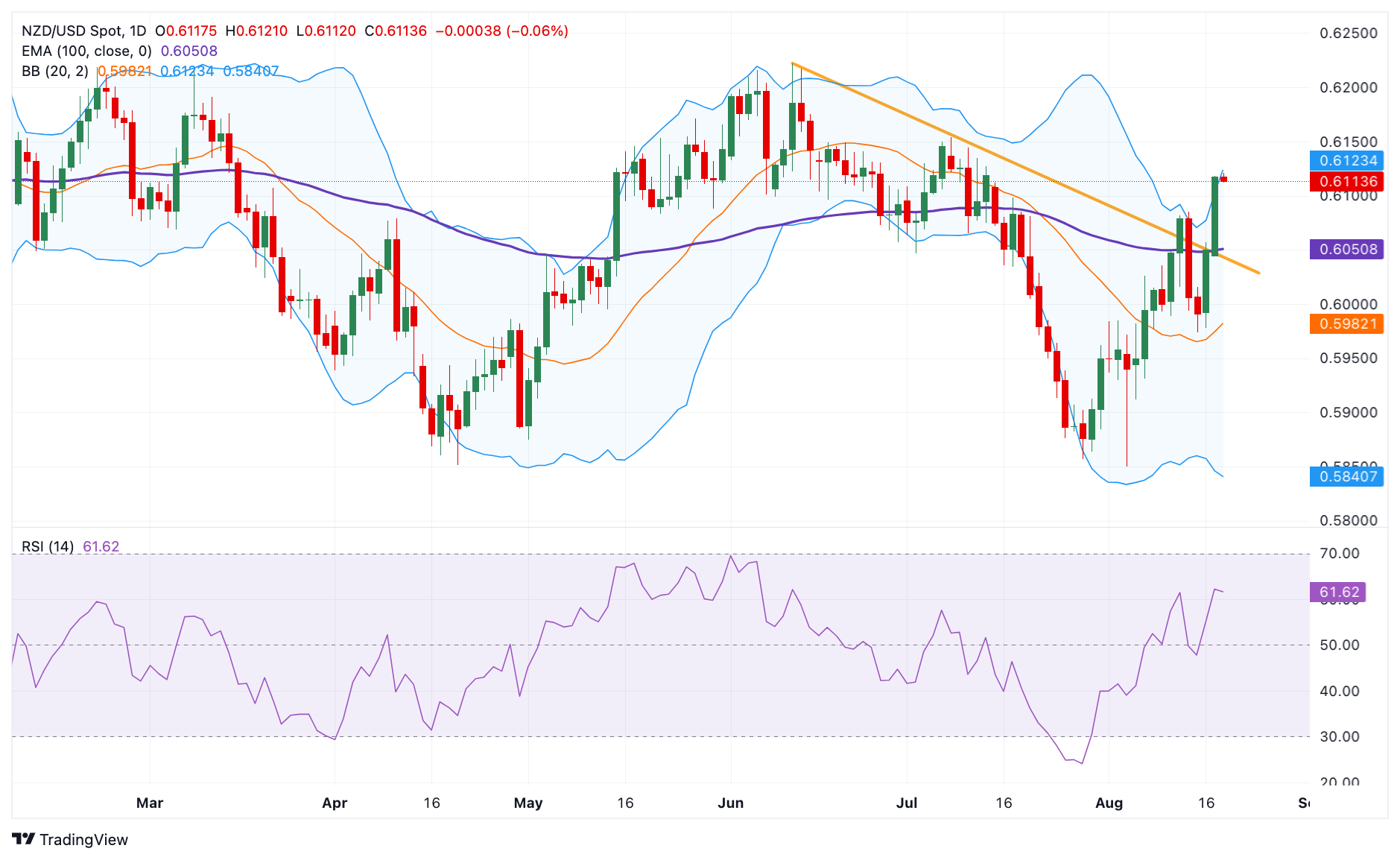
- The New Zealand Dollar gains momentum in Tuesday’s Asian session.
- The positive risk sentiment weighs on the US Dollar and lifts NZD/USD.
- Investors await the PBoC rate decision ahead of Fedspeak on Tuesday.
The New Zealand Dollar (NZD) trades in positive territory for the third consecutive day on Tuesday. The risk-on sentiment in global markets and easing geopolitical risks in the Middle East continue to undermine the Greenback. Nonetheless, the dovish remarks from the Reserve Bank of New Zealand (RBNZ) after a surprise rate cut last week might cap the pair’s upside. RBNZ Governor Adrian Orr said on Monday that he is more convinced that inflation has returned to the 1-3% target area, boosting the likelihood of more rate reductions in the future.
Looking ahead, investors will keep an eye on the People’s Bank of China’s (PBoC) Interest Rate Decision, along with the Fed’s Raphael Bostic and Michael Barr speeches on Tuesday. On Friday, New Zealand’s Retail Sales data and Fed Chair Powell’s speech at the Jackson Hole symposium will be in the spotlight.
Daily Digest Market Movers: New Zealand Dollar gathers strength amid broad USD weakness
- The People’s Bank of China (PBOC) left the one-year and five-year Loan Prime Rates (LPR) unchanged on Tuesday at 3.35% and 3.85%, respectively.
- New Zealand’s Trade Balance came in at NZD $-9.29B YoY in July versus $-9.5B prior, according to the latest data released by Statistics New Zealand on Tuesday.
- New Zealand’s Exports decreased to $6.15B in July versus $6.17B in June whereas Imports rose to $7.11B compared to $5.45B in previous readings.
- Federal Reserve Bank of Minneapolis President Neel Kashkari said on Monday that it was appropriate to discuss potentially cutting US interest rates in September due to concerns about the weakening labor market, per Reuters.
- Chicago Fed President Austan Goolsbee said on Sunday that the US economy does not show signs of overheating, so Fed policymakers should be cautious about keeping restrictive policy in place longer than necessary.
- The markets are now pricing in a nearly 77% chance of a 25 basis points (bps) Fed rate cut in its September meeting, according to the CME FedWatch Tool.
Technical Analysis: New Zealand Dollar resumes its broader bullish trend
The New Zealand Dollar edges higher on the day. The NZD/USD pair resumes its upside journey on the daily chart after breaking above the descending trendline on Monday. Furthermore, the pair holds above the key 100-day Exponential Moving Average (EMA), with the bullish 14-day Relative Strength Index (RSI) above the midline near 62.0, supporting buyers for the time being.
A decisive break above the upper boundary of the Bollinger Band at the 0.6100 psychological level could pave the way to 0.6154, the high of July 8. Further north, the next hurdle emerges at 0.6222, the high of June 12.
On the flip side, the crucial support level for NZD/USD is seen at 0.6050, representing the 100-day EMA and descending trendline. Sustained trading below this level could expose 0.5974, the low of August 15. The next contention level is located at 0.5846, the lower limit of the Bollinger Band.
US Dollar price this week
The table below shows the percentage change of US Dollar (USD) against listed major currencies this week. US Dollar was the weakest against the .
| USD | EUR | GBP | CAD | AUD | JPY | NZD | CHF | |
| USD | -0.54% | -0.32% | -0.37% | -0.84% | -1.08% | -1.07% | -0.72% | |
| EUR | 0.54% | 0.23% | 0.18% | -0.28% | -0.54% | -0.51% | -0.16% | |
| GBP | 0.32% | -0.23% | -0.05% | -0.52% | -0.76% | -0.74% | -0.39% | |
| CAD | 0.37% | -0.17% | 0.05% | -0.46% | -0.72% | -0.69% | -0.34% | |
| AUD | 0.83% | 0.29% | 0.52% | 0.48% | -0.22% | -0.22% | 0.15% | |
| JPY | 1.10% | 0.56% | 0.79% | 0.73% | 0.27% | 0.06% | 0.41% | |
| NZD | 1.06% | 0.51% | 0.73% | 0.68% | 0.21% | -0.01% | 0.35% | |
| CHF | 0.70% | 0.15% | 0.38% | 0.33% | -0.14% | -0.40% | -0.35% |
The heat map shows percentage changes of major currencies against each other. The base currency is picked from the left column, while the quote currency is picked from the top row. For example, if you pick the Euro from the left column and move along the horizontal line to the Japanese Yen, the percentage change displayed in the box will represent EUR (base)/JPY (quote).

